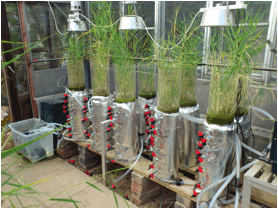Case study: Experiments in the Greenhouse
Prof. Miklas Scholz and Dr Yu Wang undertake experiments in the greenhouse (Fig. 1) located at Peel Park university campus. A current experiment is entitled Assessment of Clogging in Vertical-flow Constructed Wetland Systems

A precondition for the effective functioning of vertical-flow constructed wetland systems is sufficient hydraulic conductivity of the infiltration zone. Prolonged clogging leads to permanent ponding and anaerobic conditions within the system resulting in a drop in treatment performance. This project aims to (i) examine and differentiate diverse mechanisms and causative factors of clogging in constructed wetland systems, (ii) determine the impact of design and operational variables on the hydraulic performance and purification efficiency, and (iii) deliver a theoretical model for sediment deposition and clogging time in these systems.
Vertical-flow constructed wetland systems with intermittent dosing represent the latest generation of sub-surface flow constructed wetlands. These systems can help to fulfil stringent effluent standards. However, a major drawback limiting their competitiveness and efficiency is the concomitant biological clogging cum physical plugging, induced as a result of the excessive formation of biomass (hydrated extracellular polymers) from biocatalytic degradation of pollutants, and the retention of inert suspended fine particles that are present in the liquid influent stream. This leads to inner and outer blockage of filter substrate, reduces active pore volume and substrate hydraulic conductivity Therefore, pores cannot be aerated as would be necessary for biocatalytic degradation of pollutants, and this ultimately leads to system failure.
Five laboratory-scale wetland systems (in duplicates) treating urban wastewater have been built (Fig. 2). Different hydraulic and organic loads, dosing frequencies and other key design variables will be tested for each system to establish the impact of the operational mode on their hydraulics and treatment performance. A variety of methods including hydraulic, physical-chemical and microbiological measurements and various analytical methods for examining drinking water and wastewater will be used to assess treatment efficiency and the impact of design variables, and also examine the clogging phenomena in greater detail.
